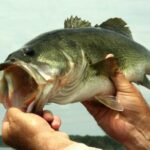For many people, a trip to the beach is all about soaking up the sun and enjoying a carefree day in the sand. But there’s another class of beachgoers that most people never see. These beachgoers aren’t there to unwind but to hunt from dusk until dawn in search of a trophy fish. They are surf anglers.
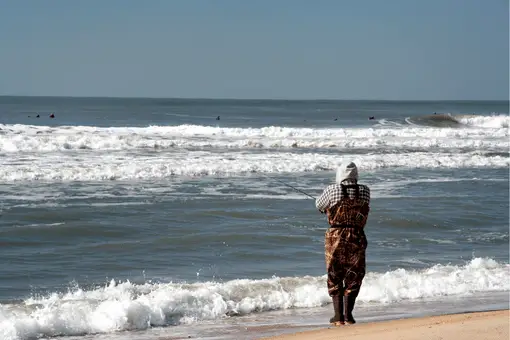
Surf fishing is one of the most exciting and rewarding ways to catch fish. It might be a bit more demanding than fishing from a boat or pier, but once you hook into your first fish from the surf, you’ll realize there’s nothing like it. Today, we’ll cover everything you need to know to begin surf fishing, including the gear you need and the best times to fish.
What Is Surf Fishing
Surf fishing is a land-based style of saltwater fishing where the angler fishes from the shoreline or wades into the surf to deliver their cast. Anglers take advantage of whatever geography is available. Sometimes that means fishing from rock jetties, wading into the surf to reach sand bars, or casting directly from the beach.
This type of fishing is accessible to all anglers, and no experience is necessary to start. There are no shortcuts in surf fishing, and the best way to become good at surf casting is to hit the beach as often as you can and take note of what is and isn’t working for you on any given trip.
Anglers have an excellent chance of landing a diverse array of surf fish when angling from the beach. Striped bass, sea trout, bluefish, fluke (flounder), and shark are popular surf targets in the northeast. Further south, rockfish (striped bass), red drum, black drum, snook, tarpon, and pompano can all be had from the surf.
Corbina, croaker, surfperch, and halibut are the most popular surf targets on the west coast. While the east coast presents opportunities to catch a variety of shark species from the surf, shark fishing from the beach is less common on the west coast.
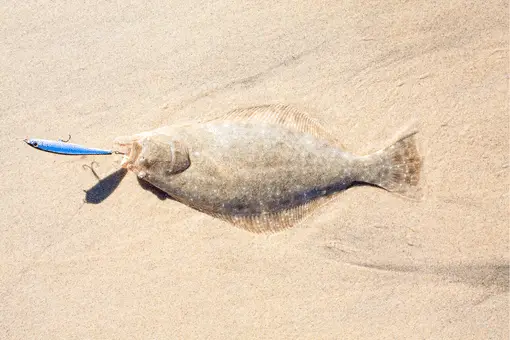
Five Tips To Learn How to Surf Fish
Follow these surf fishing tips, and you’ll be well on your way to becoming an excellent surf angler.
Have the Right Gear
When surf casting, having the right gear is critical, as the equipment you’d use for most other types of fishing doesn’t apply to this sport. Surf fishermen require specialized gear, such as long surf fishing rods and bigger reels, to cast their bait to where fish are holding. Sometimes, a 200-300 foot cast is necessary to get to the strike zone, and shorter surf rods won’t do.
Fishing from the beach also presents some unique gear challenges. Anglers must strike a delicate balance between carrying everything they need so they’re ready for any challenge and traveling as light as possible to avoid being bogged down by tons of gear.
Beyond the obvious necessities like a surf rod and reel, it makes sense to purchase a specialized bag or beach cart, so you can quickly get your gear to the spot you’ll be fishing.
When you’re fishing from the surf, you’ll need the equipment below:
- Spinning surf fishing rod (8-13’ medium-heavy power, medium to fast action)
- Surf spinning reel (8000 size or larger)
- Fishing line (30-40 pound test, monofilament, or braid)
- Shock leader
- Terminal tackle (hooks, weights, swivels)
- Bait
- Waders
- Wading boots
- First aid kit
- Pliers
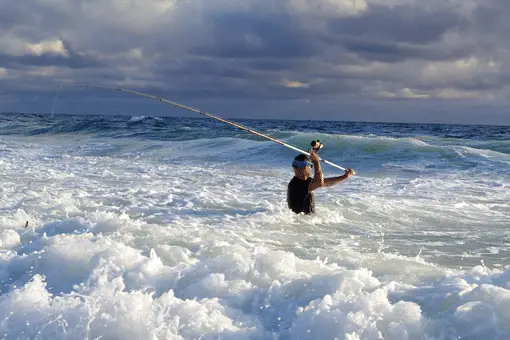
While not required, a surf angler may also benefit from:
- Artificial lures
- Tackle bag
- Beach cart
- Foul weather gear
- PFD (personal floatation device)
- Sand spike (surf rod holder)
- Headlamp
Know When to Visit the Beach
Surf fishing is all about time and opportunity. As an angler, you’ll be able to significantly improve your rewards by fishing at certain times. Fish behavior is dramatically influenced by weather, tide, and current, and understanding that will help you catch more fish from the beach.
As a rule of thumb, the two hours surrounding high tide are the most productive times of day for surf fishing. Since the moon controls the tides, the moon cycle is also essential. The new moon and full moon create the most significant tidal changes and are usually the most productive times in the surf.
While you can certainly fish during low tide, it usually yields fewer catches. The skinnier waters during low tide make the shore less approachable, and fish tend to push out to sea. While you’ll have a chance to find fish during low tide, you’ll have better luck as the tide rises.
Many fish also prefer to eat at certain times of day and are most likely to feed in the hours surrounding dusk and dawn. Given that, surf anglers typically head to the beach in the evening or before sunrise.
Choose Live Bait
While artificial lures can be effective, using live bait is the best way to get started. They’re easy to use, require less skill from the angler, and any fish who comes across your bait will have a hard time resisting a free meal like that.
The best baits to use when surf fishing will differ depending on the location. You should always try to use ones native to your area as the fish will be familiar with them. Depending on where you fish, some options to consider are:
- Sand crabs
- Cut bait (pieces of fish, squid, or clams)
- Live bait fish (bunker, mullet, pinfish, etc.)
- Shrimp
When fishing with live baits, you must rig them properly so they can survive the cast and landing in the water.
First, hook the fish about ½” from the top, behind the head in front of the dorsal fin. Rigging this way allows the fish to swim freely, it’s hearty enough to survive the casting process, and the hook point is unobstructed. If you’re fishing with live shrimp, hook the shrimp through the horn behind its head, about ¼” deep.
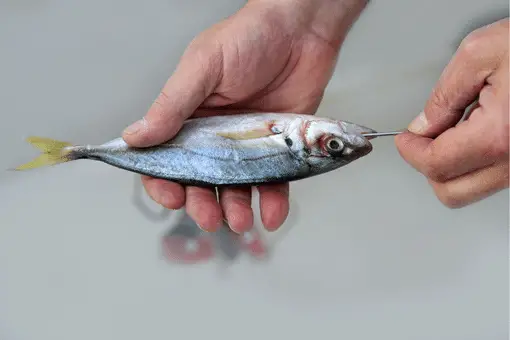
If you’re fishing with squid or clam belly, you’ll want to hook the bait at one end, wrap it around the hook, and hook it once or twice more so it’s well secured. You’ll still want plenty of its point to show.
When using cut fish as bait, hook fish heads through the bottom jaw and out through the top of the head. For the body of a fish, start by removing the tail and threading the hook through the rear and out through the top.
Essential Surf Fishing Rigs for Live Bait
When fishing with live bait, you’ll want to be familiar with a few rigs before heading to the beach.
The fish finder rig is the first essential surf fishing rig to know, and it’s one of the easiest to tie. Here’s what you’ll need:
- 18” leader material (monofilament or fluorocarbon, 30-80lb test)
- Fishing bead
- Swivel
- Sinker slide
- Fish hook (3/0 or larger depending on target species)
- Pyramid weight (1 ounce or larger, depending on conditions)
Begin by threading the sinker slide onto your main line, followed by the fishing bead. Next, attach one end of the swivel to the main line. Tie your leader material onto the other end of the swivel, and secure the hook to the other end of your leader. Attach your weight to the sinker slide, and bait the hook.
The fish finder rig is an excellent choice because it keeps your bait close to the bottom, allowing it to flow freely in the current for a natural presentation. When a fish picks up your bait, it doesn’t feel the weight of your sinker since it can slide freely along the line. That helps prevent fish from becoming “spooked” and spitting your bait before taking the hook.
A second rig you’ll want to familiarize yourself with is the pulley rig. Here’s what you’ll need:
- 36” leader material (monofilament or fluorocarbon, 30-80lb test)
- [2] swivels
- Sinker clip
- Sputnik sinker
Start by cutting your leader material into two lengths, one slightly longer than the other. Attach the hook to the shorter length of the leader, and tie the opposite end to one of the swivels. Take the second piece of leader material, and connect it to the swivel.
Thread the second piece of leader through the other swivel, and tie the remaining end of leader material to the sinker snap. Tie your main line to the second swivel, and attach your sputnik sinker to the clip.
When you hook a fish with the pulley rig, the sliding swivel will pull the weight upward, which helps prevent tangles and makes it harder for a fish to keep close to the bottom, where you can get cut off by rocks or other bottom structures.
Pay Attention to Your Environment
Reading the beach is a critical component of successful surf fishing. When you first arrive at the beach, take time to survey your surroundings and look for areas in the water that indicate where fish may be holding. When close to shore, predatory fish often hold around rips, marking a break in the sandbar, a steep drop in water depth, or an underwater structure.
These areas are most likely to hold fish, and that’s where you should concentrate on working.
Another environmental signal to watch for is birds. It’s common to see birds “working” in a particular area, and it’s a surefire indicator that there’s tons of bait in the area. Usually, the fish aren’t far behind.
Adapt Your Tactics
The most successful anglers are the ones that constantly adapt their tactics to suit the challenges of the day. Here are a few essential pointers to remember to help you maximize your time on the beach.
- Keep a journal of your fishing trips, noting the time of day, sea conditions, tide conditions, and field observations.
- Use a pulley rig when fishing a rocky bottom to minimize snags
- When fishing a rocky bottom, quickly crank the reel two to three times once you reach the bottom to pick your bait up off the seafloor, where it’s more likely to get snagged.
- Use a shock leader to withstand the impact of casting so you can avoid crack-offs.
Conclusion
Surf fishing is a labor of love, and while it may be the most physically and mentally demanding type of saltwater fishing, it’s also the most rewarding. Whether you’re a beginner or an experienced angler giving fishing at the beach a try for the first time, anyone can become good, provided you’re willing to put the time and effort in.
Invest in quality gear, pay close attention to the moon cycle and tide forecast, and be ready to adapt to changing conditions. If you follow these simple surf fishing tips, you’ll be well on your way to landing trophy fish from the surf in no time.
- Do You Need An Indicator For Nymph Fishing? - November 16, 2023
- Fishing Safety Tips For Families - September 25, 2023
- What Is The Best Time To Night Fish At A Lake? - September 18, 2023



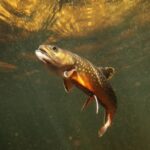
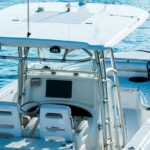


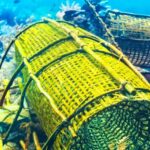
![Kayak Fishing for Beginners [10 Tips for a Successful Trip] fishing kayak moored on a beach](https://irvinelake.net/wp-content/uploads/2022/12/kayak-fishing-for-beginners-150x150.png)
